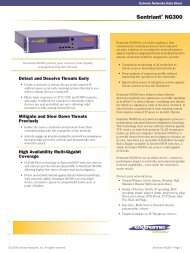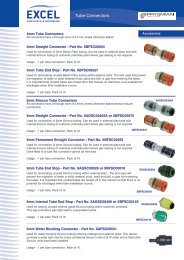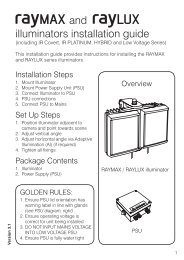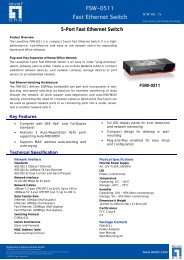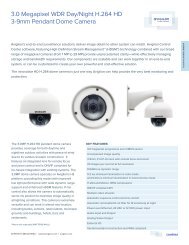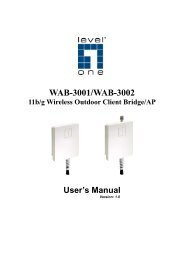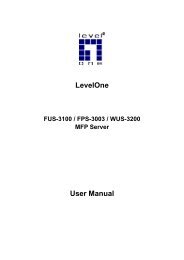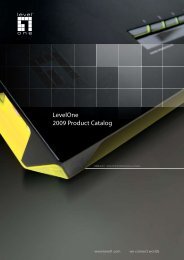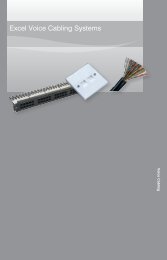Excel Blown Fibre Solutions - Mayflex
Excel Blown Fibre Solutions - Mayflex
Excel Blown Fibre Solutions - Mayflex
You also want an ePaper? Increase the reach of your titles
YUMPU automatically turns print PDFs into web optimized ePapers that Google loves.
<strong>Blown</strong> <strong>Fibre</strong>The History<strong>Blown</strong> fibre Systems as we know them were originally developed by Pirelli in partnership with British Telecom (BT). Pirelli has spun offits cabling division renaming it Prysmian and has continued to evolve and develop the system resulting in more and more benefits.Today, BT still owns the intellectual property and Prysmian is able to market the product providing an umbrella licence. Part of theagreement is that only trained personnel install the product, and this training is vital, not only to ensure performance, but also toensure good practices and safety.Originally designed for the carrier network, the system is now breaking into the enterprise market and is particularly useful in campusinstallations, including both industrial and office campuses. Recently, with the growth in data centres, the benefits of quick repair,expansion and upgrades are being realised.Real BenefitsAt its simplest, blown fibre uses a series of fitted ducts issued to install fibre between locations. The foundation is the installation of aduct network (the ducts are available in various tube counts and construction meaning internal, direct bury and direct install gradesbetween required locations). The aim is to install the duct cable so that every location is linked, either point to point or, more efficiently,in a loop. Provision should be included for redundant ducting to allow for future expansion. The duct can easily be re-configured if thedesign evolves or changes.The key to a good installation in the enterprise market is to work from the destinations back to the source(s), rather than the traditionalmethod of starting with a large multi-core and breaking it down. This will assure that the minimum number and category of fibre isaccounted for with sufficient future tube capacities. <strong>Blown</strong> fibre is very easy to install and modify, and there are huge time savings.The major benefits to blown fibre are very easy to pinpoint and the comparison to more conventional installation methods is vast.InvestmentOne of the key benefits is by initially investing in a well designed future proofed duct network; the fibre core costs and terminationcan be deferred until actually needed. Then, when a network requires expanding, the new fibre units are blown in quickly and withoutphysical disruption to the fabric of the building or campus. Money is not tied up in having the fibre cores installed, and terminated,for a number of years when they are not being used (and may never be used) and redundant fibre units can be very quickly removedusing the same blowing equipment, making the ducts available for the future. As and when new grades of fibre are developed this canbe quickly and easily deployed as necessary.This approach to staged deployment assists both initial budgeting and future investments. Network Managers can invest on day onein a duct network which is populated with fibres as required. As business needs change, either in terms of capacity or performancerequired, more fibre, or a different class of fibre, can be installed quickly and easily, often when the rest of the network continues tooperate.Repair and UpgradeWhether there is a need to replace a damaged cable or upgrade a larger section of the infrastructure, blown fibre makes it very simple.<strong>Blown</strong> fibre can be described as a ‘plug and play’ solution as that is exactly how the duct cable is joined with push fit connectors. Theducts are installed and the fibre is blown in, it only then needs to be spliced and then the job is complete and ready for use. If damageoccurs to the duct cable and fibre the ‘Mean Time to Repair’ is very fast. Simply locate the damage, open up the outer sheath of theduct cable using standard cable tools, locate the damaged duct(s), cut the duct, blow the fibre unit out, join the duct with push fitconnectors (the section of duct cable can be cut out and replaced if needs be), blow in the replacement fibre unit, terminate & test andthen the fibre is ready for reconnection. What used to take days, now can be reduced to hours to repair. And if some of the ducts haveintact fibre units they do not need to be disconnected or compromised. This is hugely advantageous for data centres where time iscritical and may be subject to costly Service Level Agreements (SLA).How long does it actually take? It can take just a few minutes to remove old fibre and new fibre is blown in at 30 metres per minute,meaning that the whole process, including termination and testing, can be completed within the hour.




